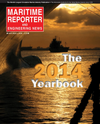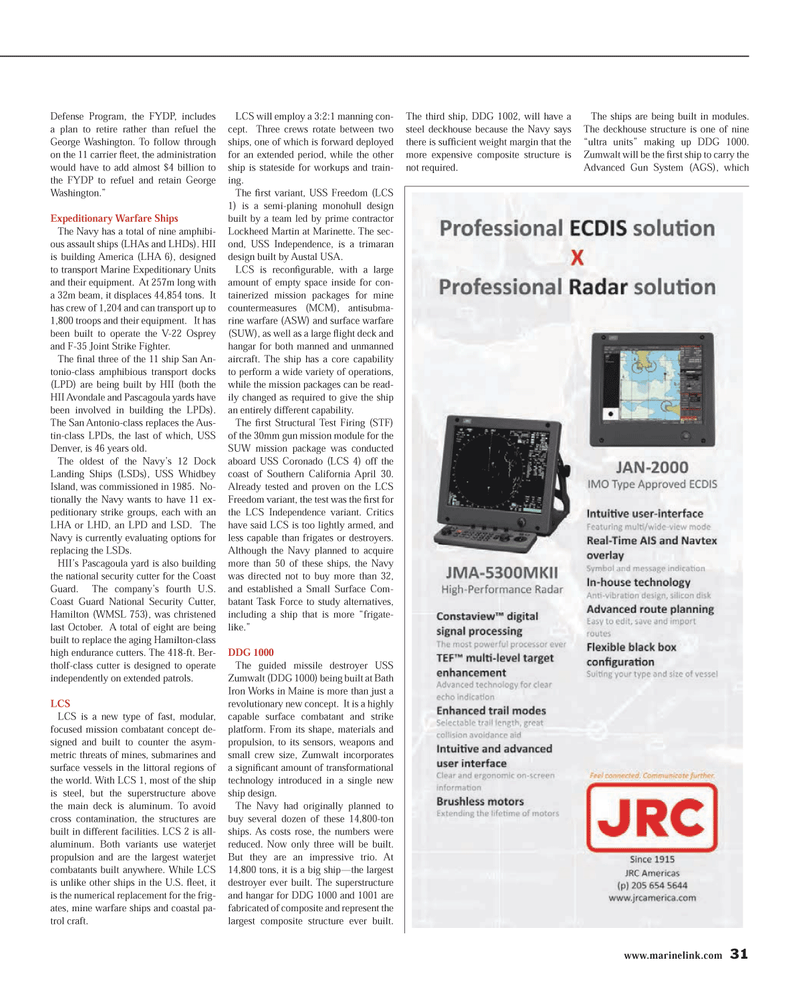
Page 31: of Maritime Reporter Magazine (June 2014)
Annual World Yearbook
Read this page in Pdf, Flash or Html5 edition of June 2014 Maritime Reporter Magazine
www.marinelink.com 31
Defense Program, the FYDP, includes a plan to retire rather than refuel the
George Washington. To follow through on the 11 carrier ? eet, the administration would have to add almost $4 billion to the FYDP to refuel and retain George
Washington.”
Expeditionary Warfare Ships
The Navy has a total of nine amphibi- ous assault ships (LHAs and LHDs). HII is building America (LHA 6), designed to transport Marine Expeditionary Units and their equipment. At 257m long with a 32m beam, it displaces 44,854 tons. It has crew of 1,204 and can transport up to 1,800 troops and their equipment. It has been built to operate the V-22 Osprey and F-35 Joint Strike Fighter.
The ? nal three of the 11 ship San An- tonio-class amphibious transport docks (LPD) are being built by HII (both the
HII Avondale and Pascagoula yards have been involved in building the LPDs).
The San Antonio-class replaces the Aus- tin-class LPDs, the last of which, USS
Denver, is 46 years old.
The oldest of the Navy’s 12 Dock
Landing Ships (LSDs), USS Whidbey
Island, was commissioned in 1985. No- tionally the Navy wants to have 11 ex- peditionary strike groups, each with an
LHA or LHD, an LPD and LSD. The
Navy is currently evaluating options for replacing the LSDs.
HII’s Pascagoula yard is also building the national security cutter for the Coast
Guard. The company’s fourth U.S.
Coast Guard National Security Cutter,
Hamilton (WMSL 753), was christened last October. A total of eight are being built to replace the aging Hamilton-class high endurance cutters. The 418-ft. Ber- tholf-class cutter is designed to operate independently on extended patrols.
LCS
LCS is a new type of fast, modular, focused mission combatant concept de- signed and built to counter the asym- metric threats of mines, submarines and surface vessels in the littoral regions of the world. With LCS 1, most of the ship is steel, but the superstructure above the main deck is aluminum. To avoid cross contamination, the structures are built in different facilities. LCS 2 is all- aluminum. Both variants use waterjet propulsion and are the largest waterjet combatants built anywhere. While LCS is unlike other ships in the U.S. ? eet, it is the numerical replacement for the frig- ates, mine warfare ships and coastal pa- trol craft.
LCS will employ a 3:2:1 manning con- cept. Three crews rotate between two ships, one of which is forward deployed for an extended period, while the other ship is stateside for workups and train- ing.
The ? rst variant, USS Freedom (LCS 1) is a semi-planing monohull design built by a team led by prime contractor
Lockheed Martin at Marinette. The sec- ond, USS Independence, is a trimaran design built by Austal USA.
LCS is recon? gurable, with a large amount of empty space inside for con- tainerized mission packages for mine countermeasures (MCM), antisubma- rine warfare (ASW) and surface warfare (SUW), as well as a large ? ight deck and hangar for both manned and unmanned aircraft. The ship has a core capability to perform a wide variety of operations, while the mission packages can be read- ily changed as required to give the ship an entirely different capability.
The ? rst Structural Test Firing (STF) of the 30mm gun mission module for the
SUW mission package was conducted aboard USS Coronado (LCS 4) off the coast of Southern California April 30.
Already tested and proven on the LCS
Freedom variant, the test was the ? rst for the LCS Independence variant. Critics have said LCS is too lightly armed, and less capable than frigates or destroyers.
Although the Navy planned to acquire more than 50 of these ships, the Navy was directed not to buy more than 32, and established a Small Surface Com- batant Task Force to study alternatives, including a ship that is more “frigate- like.”
DDG 1000
The guided missile destroyer USS
Zumwalt (DDG 1000) being built at Bath
Iron Works in Maine is more than just a revolutionary new concept. It is a highly capable surface combatant and strike platform. From its shape, materials and propulsion, to its sensors, weapons and small crew size, Zumwalt incorporates a signi? cant amount of transformational technology introduced in a single new ship design.
The Navy had originally planned to buy several dozen of these 14,800-ton ships. As costs rose, the numbers were reduced. Now only three will be built.
But they are an impressive trio. At 14,800 tons, it is a big ship—the largest destroyer ever built. The superstructure and hangar for DDG 1000 and 1001 are fabricated of composite and represent the largest composite structure ever built.
The third ship, DDG 1002, will have a steel deckhouse because the Navy says there is suf? cient weight margin that the more expensive composite structure is not required.
The ships are being built in modules.
The deckhouse structure is one of nine “ultra units” making up DDG 1000.
Zumwalt will be the ? rst ship to carry the
Advanced Gun System (AGS), which
MR #6 (26-33).indd 31 5/29/2014 9:13:29 AM

 30
30

 32
32
